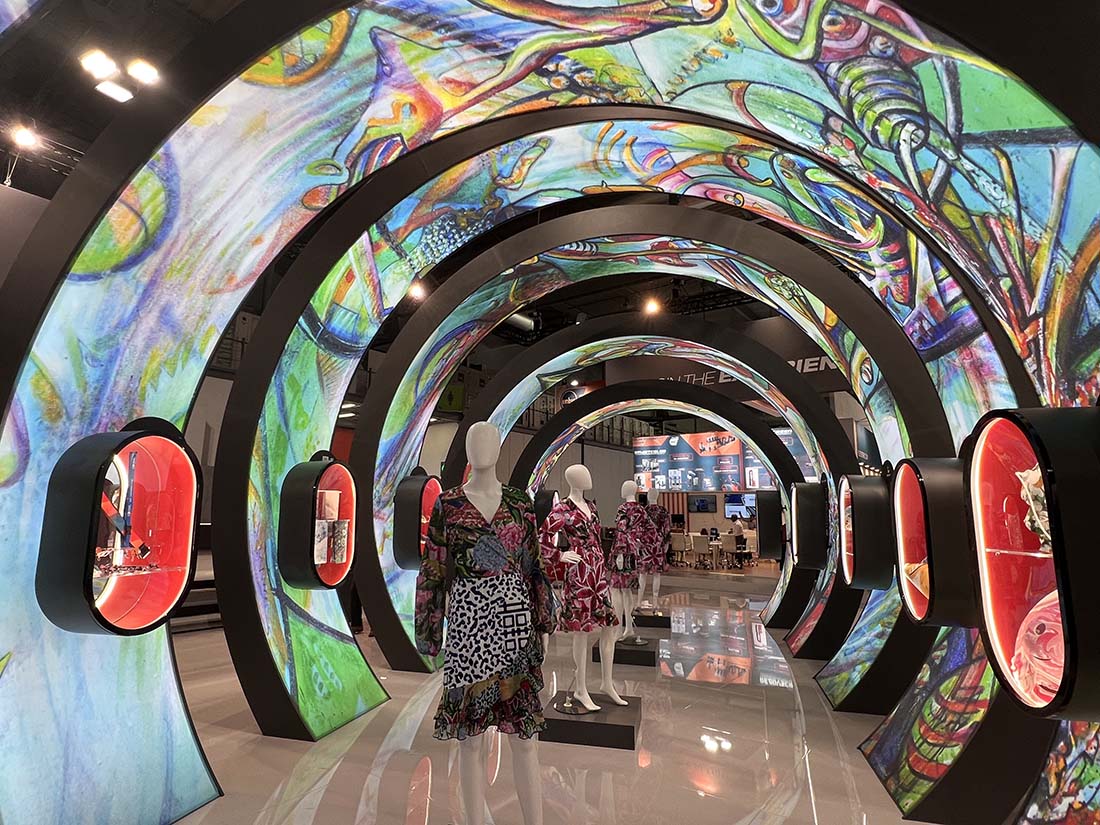Sustainable dyeing of textiles and textile recycling garners attention at ITMA Milan, with other innovations that increase textile sustainability and offer textile producers on-demand options.
The best and brightest ideas from leading companies and new players in textile manufacturing and production were plentiful at ITMA Milan, which delivered on expectations. It is difficult to share all aspects that would do all justice. Rest assured, themes like reshoring, automation, production, traceability, circularity, and more, will be shared in future issues. Yet, two areas exhibited exponential innovation – playing a role in the emerging textile circular economy. They are digital textile printing and textile recycling. To understand the innovations, you must first review the issues they seek to solve.
Impacts and Solutions
The textile industry’s exorbitant use of resources and generated waste are ever-present issues. As a reminder, according to the Geneva Environment Network (www.genevaenvironmentnetwork.org) in just fast fashion textiles alone, the statistics are grave. A search for sustainable fashion on their website is worth a look. Here are just a few facts that rising innovation can correct if adapted:
- The equivalent of one garbage truck full of clothes is burned or dumped in a landfill every second (UNEP, 2018)
- Approximately 60% of all materials used by the fashion industry are made from plastic (UNEP, 2019)
- 500,000 tons of microfibers are released into the ocean each year from washing clothes — the equivalent of 50 billion plastic bottles (Ellen MacArthur Foundation, 2017)
- The fashion industry is responsible for 8-10% of humanity’s carbon emissions – more than all international flights and maritime shipping combined (UNEP, 2018). If the fashion sector continues on its current trajectory, that share of the carbon budget could jump to 26% by 2050 (Ellen Mac-
- Arthur Foundation, 2017)
- Some 93 billion cubic meters of water – enough to meet the needs of five million people – is used by the fashion industry annually, contributing significantly to water scarcity in some regions (UNCTAD, 2020)
- Around 20% of industrial wastewater pollution worldwide originates from the fashion industry (WRI, 2017)
In the panel on Development of a Sustainable Digital Future, Kevin McCoy, Vice President, MADE, New Balance Athletics Inc., says, “You must look at the value. Doing the right thing is hard and can be expensive. Know that up front you’ll get attention as a challenger to the status quo. Regardless of technology, it starts with design. Design for manufacturing.”

These thoughts were echoed by others. During a press event discussion centered on Kornit Digital’s advancements (we will get to those shortly), Muriel Laurent, Director of Digital Marketing, at SOL’S believes that on demand and digital production are key to the future of textiles. “Print on demand is the most sustainable option for the future.” Jaymes Clements of Mad Engine says, “Retail brick and mortar have limited space. There is no need to premanufacture, when the product can only exists because someone has purchased it,” believing that this is a reliable business model for ensuring stability, efficiency, and growth in dynamic circumstances.
“Offering increased level of creativity, taking digital mainstream, brands need to change the way they think about production,” emphasizes Ronen Samuel, Chief Executive Officer at Kornit Digital. “With the ability to print on any kind of fabric, save resources, automated utilization systems, it is an evolution the industry has never seen before.”

Alon Moshe, Twine Solutions CEO, comments on the company’s newest technology, the TwineX4 digital yarn and thread dyeing system. “We believe this system represents the future of textile production and will be a huge change for our customers. We are confident that it will help textile manufacturers increase efficiency, reduce costs, and produce more sustainably.” The convenience of on-demand, in-house thread and yarn digital dyeing for small to medium-sized batches eliminates supply delays, supports the implementation of lower waste-to-landfill goals, reduces CO2 emissions in transportation, and has significant water and energy savings.
Switching topics to end-of-life textiles processing, the concept of recycling is catching on, but … Ever. So. Slowly. A McKinsey Sustainability report notes that less than 1% of textiles produced for clothing are recycled into new clothing, representing a missed revenue opportunity of more than $100 billion a year. With the popularity of synthetic blends, that task is complex, time consuming and expensive. Yet, big brands like Levis, Adidas, and Zara have made recent news on their commitments to textile recycling.
New waste legislation in the U.S. could fast track recycling. A CNBC* news article recently reported, “In New York State, The Fashion Sustainability and Social Accountability Act, also known as the Fashion Act, would hold companies accountable for their recycling practices. It is currently backed by fashion brands like Eileen Fisher, Stella McCartney, Everlane, and Patagonia, as well as other advocacy organizations pushing to pass the bill.”
With those points made, let’s get back to solutions. ITMA Milan showcased many, and here are the ones that stood out with a splash of color.
- https://www.cnbc.com/2023/06/11/a-recycled-idea-at-levis-adidas-to-stop-clothing-from-going-to-waste.html


